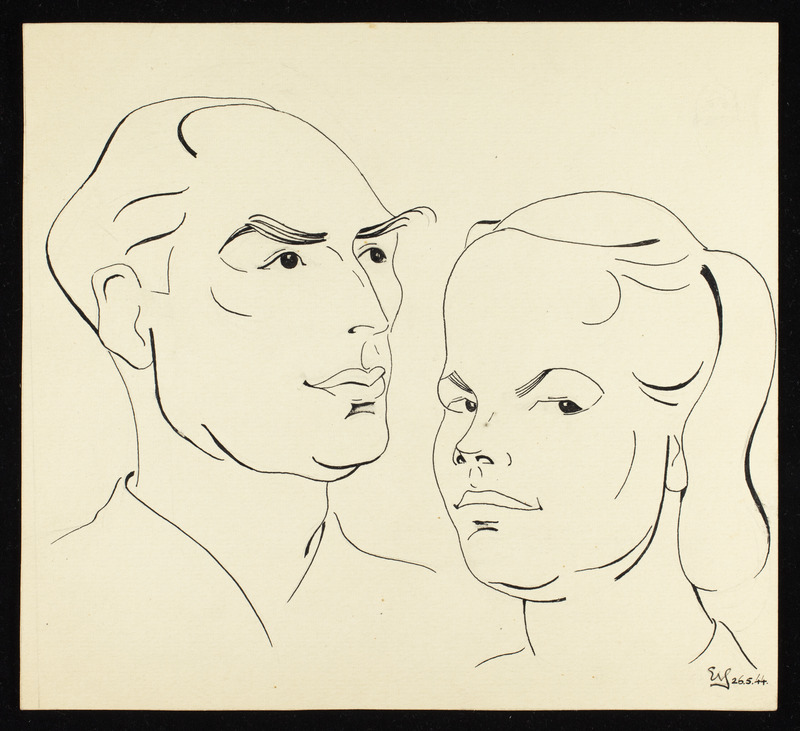Biographical/Historical Information
Etta Ottilie Veit-Simon Japha was born in Berlin on 29 August 1918, the daughter of Heinrich (Heinz) Veit-Simon (1883-1942), a Jewish lawyer, and Irmgard Margarete Emma Veit-Simon, née Gabriel (1889-1971), a gentile. Heinrich Veit-Simon and Irmgard Gabriel had six children, of whom Etta Japha was the second youngest. Etta's siblings were Harro (1911-2011), Ruth (1914-1943), Ulla (1915-2004), Rolf (1916-1943), and Judith (1925-2016). The children were raised in the Jewish faith, as members of the reform Jewish community. Rabbi Leo Baeck was a family friend; he presided over Etta Japha's bat mitzvah in 1934. From 1933 on, Heinrich Veit-Simon was barred from his profession, until lost his law firm entirely in November 1938. During Kristallnacht on November 9, he was arrested and imprisoned in the Sachsenhausen concentration camp for several weeks.
By the end of the 1930s, four of the Veit-Simon siblings had left Germany, and only Ruth and Etta remained in Berlin with their parents. Harro went to Spain, eventually settling in Chile. Ulla emigrated to London in 1938, with her husband, Erich Sonntag, and their two daughters. The youngest sibling, Judith, also went to England, on a Kindertransport, in December 1938. Rolf settled in the Netherlands around fall 1938; he and his wife were arrested and detained at the Westerbork transit camp and then deported to Auschwitz, where they both perished. Ruth contracted tuberculosis in 1937; she was deported to Theresienstadt and admitted to the TB unit in the camp hospital, where she died on 26 July 1943. Etta’s father Heinrich Veit-Simon was arrested in April 1942; he was held at the police prison at Alexanderplatz, where he died. Etta’s grandmother Hedwig, and aunts Eva and Käte Veit-Simon were also deported, arriving in Theresienstadt in early October. Another relative imprisoned there was Max Pollnow (1884-1944), a cousin of their father, along with his wife Edith (1894-1943). Hedwig Veit-Simon died in Theresienstadt on 1 April 1943. Eva and Käte, who worked in sewing and knitting production at Theresienstadt, were deported to Auschwitz in mid-May 1944, and Max Pollnow that fall; they all perished there.
After graduating from a girls' school in Berlin in 1937, Etta began an apprenticeship as a graphic designer, a commitment that she kept even during her imprisonment in Theresienstadt, when she worked at the graphics workshop for the camp’s Jewish self-administration. Like other artists in this group, she managed to covertly make sketches and drawings of her own, documenting her life there. After the liberation of Theresienstadt in early May 1945, Etta worked on repatriating survivors to their home countries. She arranged emigration to England for her mother (who was still living in Berlin), and herself, arriving in London in the fall of 1945, joining Etta's sisters Ulla and Judith and their families. Etta worked as a commercial and freelance lettering artist until emigrating to the United States in November 1949. Her sisters and her mother followed eventually.
In 1952, Etta married the German-born physician Erwin Maximilian Japha (1910-1971), who had two children from a prior marriage in England. Etta and Erwin Japha settled in Chicago, where their daughter Irene Ruth was born in 1954. After her husband’s death, Etta resumed her interest in art, exhibiting and selling her work from 1978 on. She then moved to California and then to Washington. Etta Japha died in Seattle on 9 June 2009 at the age of 90.
Reproductions and Permissions
We welcome fair use of this content. Please credit the Leo Baeck Institute in your citation. For usage policies and to request higher resolution images, see Reproductions and Permissions.
Citation
Japha, Etta: Portfolio of drawings from Theresienstadt, Leo Baeck Institute, 2025.02a-h.
